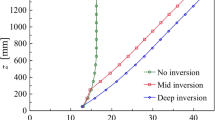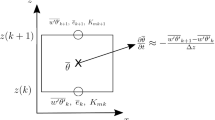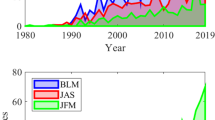Abstract
For many decades, attempts have been made to find the universal value of the critical bulk Richardson number (\(Ri_{Bc}\); defined over the entire stable boundary layer). By analyzing an extensive large-eddy simulation database and various published wind-tunnel data, we show that \(Ri_{Bc}\) is not a constant, rather it strongly depends on bulk atmospheric stability. A (qualitatively) similar dependency, based on the well-known resistance laws, was reported by Melgarejo and Deardorff (J Atmos Sci 31:1324–1333, 1974) about forty years ago. To the best of our knowledge, this result has largely been ignored. Based on data analysis, we find that the stability-dependent \(Ri_{Bc}\) estimates boundary-layer height more accurately than the conventional constant \(Ri_{Bc}\) approach. Furthermore, our results indicate that the common practice of setting \(Ri_{Bc}\) as a constant in numerical modelling studies implicitly constrains the bulk stability of the simulated boundary layer. The proposed stability-dependent \(Ri_{Bc}\) does not suffer from such an inappropriate constraint.





Similar content being viewed by others
Notes
Even though a handful of publications correctly termed \(Ri_{Bc}\) as the bulk Richardson number of the ABL (e.g., Arya 1999), the majority of published studies call it the critical bulk Richardson number. We opted to use the latter term herein.
We modified the notations to be consistent with the present work.
We modified the notations to be consistent with the present work.
References
Anderson WC, Basu S, Letchford CW (2007) Comparison of dynamic subgrid-scale models for simulations of neutrally buoyant shear-driven atmospheric boundary layer flows. Environ Fluid Mech 7:195–215
Andreas EL, Claffey KJ, Makshtas AP (2000) Low-level atmospheric jets and inversions over the western Weddell sea. Bound-Layer Meteorol 97:459–486
Arya S (1975) Buoyancy effects in a horizontal flat-plate boundary layer. J Fluid Mech 68:321–343
Arya SP (1999) Air pollution meteorology and dispersion. Oxford University Press, New York
Basu S, Porté-Agel F (2006) Large-eddy simulation of stably stratified atmospheric boundary layer turbulence: a scale-dependent dynamic modeling approach. J Atmos Sci 63:2074–2091
Basu S, Porté-Agel F, Foufoula-Georgiou E, Vinuesa JF, Pahlow M (2006) Revisiting the local scaling hypothesis in stably stratified atmospheric boundary layer turbulence: an integration of field and laboratory measurements with large-eddy simulations. Bound-Layer Meteorol 119:473–500
Basu S, Holtslag AAM, van de Wiel BJH, Moene AF, Steeneveld GJ (2008a) An inconvenient “truth” about using sensible heat flux as a surface boundary condition in models under stably stratified regimes. Acta Geophys 56:88–99
Basu S, Vinuesa JF, Swift A (2008b) Dynamic LES modeling of a diurnal cycle. J Appl Meteorol Climatol 47:1156–1174
Basu S, Holtslag AAM, Bosveld FC (2011) GABLS3 LES intercomparison study. In: ECMWF/GABLS workshop on “Diurnal cycles and the stable atmospheric boundary layer”, ECMWF, pp 75–82
Brost RA, Wyngaard JC (1978) A model study of the stably stratified planetary boundary layer. J Atmos Sci 35:1427–1440
Brown AR, Derbyshire SH, Mason PJ (1994) Large-eddy simulation of stable atmospheric boundary layers with a revised stochastic subgrid model. Q J R Meteorol Soc 120:1485–1512
Clarke RH, Dyer AJ, Brook RR, Reid DG, Troup AJ (1971) The Wangara experiment: boundary layer data. Technical paper no. 19. CSIRO, Division of Atmospheric Physics. Aspendale, Australia, p 362
Esau I, Zilitinkevich S (2010) On the role of the planetary boundary layer depth in the climate system. Adv Sci Res 4:63–69
Esau IN, Zilitinkevich SS (2006) Universal dependences between turbulent and mean flow parameters instably and neutrally stratified planetary boundary layers. Nonlinear Process Geophys 13:135–144
García JA, Cancillo ML, Cano JL (2002) A case study of the morning evolution of the convective boundary layer depth. J Appl Meteorol 41:1053–1059
Garratt JR (1992) The atmospheric boundary layer. Cambridge University Press, Cambridge
Gryning SE, Batchvarova E (2003) Marine atmospheric boundary-layer height estimated from NWP model output. Int J Environ Pollut 20:147–153
Hanna SR (1969) The thickness of the planetary boundary layer. Atmos Environ 3:519–536
Heinemann G, Rose L (1990) Surface energy balance, parameterizations of boundary-layer heights and the application of resistance laws near an Antarctic ice shelf front. Bound-Layer Meteorol 51:123–158
Holtslag AAM, Boville BA (1993) Local versus nonlocal boundary-layer diffusion in a global climate model. J Clim 6:1825–1842
Holtslag AAM, de Bruijn EIF, Pan HL (1990) A high resolution air mass transformation model for short-range weather forecasting. Mon Weather Rev 118:1561–1575
Holtslag AAM, Steeneveld GJ, van de Wiel BJH (2007) Role of land surface temperature feedback on model performance for stable boundary layers. Bound-Layer Meteorol 125:361–376
Hong SY (2010) A new stable boundary-layer mixing scheme and its impact on the simulated East Asian summer monsoon. Q J R Meteorol Soc 136:1481–1496
Jeričević A, Grisogono B (2006) The critical bulk Richardson number in urban areas: verification and application in numerical weather prediction model. Tellus 58A:19–27
Jiménez MA, Cuxart J (2005) Large-eddy simulations of the stable boundary layer using the standard Kolmogorov theory: range of applicability. Bound-Layer Meteorol 115:241–261
Kiehl J, Hack J, Bonan G, Boville B, Williamson D, Rasch P (1998) The National Center for Atmospheric Research Community Climate Model: CCM3. J Clim 11(6):1131–1149
Mahrt L (1981) Modelling the depth of the stable boundary-layer. Bound-Layer Meteorol 21:3–19
Melgarejo JW, Deardorff JW (1974) Stability functions for the boundary-layer resistance laws based upon observed boundary-layer heights. J Atmos Sci 31:1324–1333
Nieuwstadt FTM (1984) The turbulent structure of the stable, nocturnal boundary layer. J Atmos Sci 41(14):2202–2216
Nieuwstadt FTM (1985) A model for the stationary, stable boundary layer. In: Hunt JCR (ed) Turbulence and diffusion in stable environments. Clarendon Press, Oxford, pp 149–179
Ohya Y (2001) Wind-tunnel study of atmospheric stable boundary layers over a rough surface. Bound-Layer Meteorol 98(1):57–82
Ohya Y, Uchida T (2003) Turbulence structure of stable boundary layers with a near-linear temperature profile. Bound-Layer Meteorol 108(1):19–38
Ohya Y, Neff D, Meroney R (1997) Turbulence structure in a stratified boundary layer under stable conditions. Bound-Layer Meteorol 83(1):139–161
Pichugina Y, Banta R (2010) Stable boundary layer depth from high-resolution measurements of the mean wind profile. J Appl Meteorol Climatol 49(1):20–35
Saiki EM, Moeng CH, Sullivan PP (2000) Large-eddy simulation of the stably stratified planetary boundary layer. Bound-Layer Meteorol 95:1–30
Seibert P, Beyrich F, Gryning SE, Joffre S, Rasmussen A, Tercier P (1998) Mixing height determination for dispersion modelling, COST action 710-final report, harmonisation of the pre-processing of meteorological data for atmospheric dispersion models, L-2985. European Commission, Luxembourg, EUR 18195 EN (ISBN 92-828-3302-X)
Sørensen JH, Rasmussen A, Svensmark H (1996) Forecast of atmospheric boundary-layer height utilised for ETEX real-time dispersion modelling. Phys Chem Earth 21:435–439
Steeneveld GJ, van de Wiel BJH, Holtslag AAM (2007) Diagnostic equations for the stable boundary layer height: evaluation and dimensional analysis. J Appl Meteorol Climatol 46(2):212–225
Stoll R, Porté-Agel F (2008) Large-eddy simulation of the stable atmospheric boundary layer using dynamic models with different averaging schemes. Bound-Layer Meteorol 126(1):1–28
Stull RB (1988) An introduction to boundary layer meteorology. Kluwer Academic Publishers, Dordrecht
Troen I, Mahrt L (1986) A simple model of the atmospheric boundary layer; sensitivity to surface evaporation. Bound-Layer Meteorol 37:129–148
Vickers D, Mahrt L (2004) Evaluating formulations of stable boundary layer height. J Appl Meteorol 43: 1736–1749
Vinuesa JF, Basu S, Galmarini S (2007) The diurnal evolution of \(^{222}\) Rn and its progeny in the atmospheric boundary layer during the Wangara experiment. Atmos Chem Phys 7:5003–5019
Vogelezang DHP, Holtslag AAM (1996) Evaluation and model impacts of alternative boundary-layer height formulations. Bound-Layer Meteorol 81:245–269
van de Wiel BJH, Moene AF, Jonker HJJ, Baas P, Basu S, Donda JMM, Sun J, Holtslag AAM (2012) The minimum wind speed for sustainable turbulence in the nocturnal boundary layer. J Atmos Sci 69:3116–3127
Yamada T (1976) On the similarity functions A, B and C of the planetary boundary layer. J Atmos Sci 33:781–793
Zilitinkevich S, Baklanov A (2002) Calculation of the height of the stable boundary layer in practical applications. Bound-Layer Meteorol 105:389–409
Acknowledgments
The authors are grateful to Larry Mahrt, Pal Arya, and Sethu Raman for useful discussions. The authors acknowledge the financial support received from the National Science Foundation by way of Grant AGS-1122315. Any opinions, findings and conclusions or recommendations expressed in this material are those of the authors and do not necessarily reflect the views of the National Science Foundation.
Author information
Authors and Affiliations
Corresponding author
Appendix A
Appendix A
1.1 A.1 Estimation of \(h\) from LES
There is a general consensus in the literature that the estimation of \(h\) from observational data is a challenging task. Over the years, several variables have been explored for this purpose, including (but not limited to): wind speed, wind-speed profile curvature, streamwise velocity variance, vertical velocity variance, momentum flux, buoyancy flux, and gradient Richardson number (see Vickers and Mahrt 2004; Steeneveld et al. 2007; Pichugina and Banta 2010 and references therein). Even though, in the case of observational data, different profiles could lead to significantly different estimates of \(h\), this is not the case for the LES-generated data. In Fig. 6, we plot vertical profiles of velocity components, (resolved) variances, (total) momentum fluxes and (total) sensible heat fluxes. It is clear that \(h\) estimated from most of these profiles is more-or-less similar. Sensible heat-flux profiles usually lead to marginally higher estimates of \(h\) (see also Basu and Porté-Agel 2006; Stoll and Porté-Agel 2008).
The panels from top to bottom correspond to the vertical profiles of horizontal velocity components, variances, momentum fluxes, and sensible heat fluxes, respectively. The simulation shown on the left panel used \(G = 12\,\text{ m }\,\text{ s }^{-1}\) and \(C = 0.75\,\text{ K }\,\text{ h }^{-1}\), whereas the right one used \(G = 6\, \text{ m }\,\text{ s }^{-1}\) and \(C = 1.25\,\text{ K }\,\text{ h }^{-1}\). All these panels represent the last 6 h of the simulations. The 25th, 50th, and 75th percentiles are shown to depict the temporal variabilities. On each panel, \(h\) estimated from the peak of LLJ is overlayed
Similar to Fig. 2 (top-left panel) and Fig. 4, the dependencies of \(Ri_{Bc}\) on \(h/L\) are shown in Fig. 7. In these panels, the vertical profiles of momentum flux (left panel) and (resolved) horizontal velocity variance (right panel) are utilized for the estimation of \(h\). The locations where the momentum flux and (resolved) horizontal velocity variance decrease to less than 10 % of their respective surface value are denoted as \(h\). These estimates of \(h\) in conjunction with Eq. 2 are used for the calculation of \(Ri_{Bc}\). The scatter and the slopes of the linear regression in these figures are slightly larger than those in the top-left panel of Fig. 2. However, the trend is once again clear. Without any doubt, \(Ri_{Bc}\) increases with increasing stability.
Variation of \(Ri_{Bc}\) with respect to \(h/L\) based on LES-generated samples. The red lines denote the best-fit linear regression line (with the constraint of passing through the origin). \(h\) is estimated from the profiles of (total) momentum flux (left panel) and (resolved) horizontal velocity variance (right panel), respectively
1.2 A.2 Sensitivity Experiments
In this appendix, we document the effects of grid resolution and longwave radiation on the LES-generated data. We consider three cases representing distinct stability regimes: (i) weakly stable (\(h/L \approx 3\)), (ii) moderately stable (\(h/L \approx 6\)), and (iii) very stable (\(h/L \approx 9\)). We perform several 6-h long simulations using a range of grid sizes (5–10 m). In line with the LES database, some simulations use a domain size of 800 m \(\times \) 800 m \(\times \) 790 m, while a few others use a smaller domain size of 400 m \(\times \) 400 m \(\times \) 400 m. In some simulations, a radiation scheme is utilized. Recently, we incorporated the Column Radiation Model (CRM; version 2.1.7) in our MATLES code. CRM is a stand-alone version of the radiation code utilized by the NCAR Community Climate Model (Kiehl et al. 1998). See Table 2 for the specifications of all the these simulations.
The results from the sensitivity experiments are reported in Table 3 and Fig. 8. All the profiles and statistics are computed from the last 30 min of the simulations. The following statements can be made based on these results:
-
for the weakly stable case, the surface fluxes are almost independent of grid resolution. For all other cases, the surface fluxes minutely decrease with increasing resolutions;
-
for all the cases, \(h\) decreases with increasing resolution;
-
for all the cases, the values of \(h/L\) estimated from the fine-resolution runs are within 10 % of their corresponding coarse-resolution values;
-
\(Ri_{Bc}\) decreases with increasing resolution. For the very stable case, \(Ri_{Bc}\) decreases by almost 25 %; whereas, in the case of the weakly stable case, it decreases by only \(\approx 8\) %;
-
\(\alpha \) varies with grid-resolution;
-
the overall impact of longwave radiation on the simulated statistics is marginal; and
-
most importantly, \(Ri_{Bc}\) increases with increasing stability. This trend is not masked by the effects of grid resolution and radiation.
The panels from top to bottom correspond to the vertical profiles of wind speed, vertical profiles of potential temperature, time series of friction velocity, and time series of sensible heat fluxes, respectively. All the profiles are computed from the last 30 min of the simulations. The simulation shown on the left panel used \(G = 12\,\text{ m } \,\text{ s }^{-1}\) and \(C = 2.00\,\text{ K }\,\text{ h }^{-1}\), whereas the right one used \(G = 6\,\text{ m } \,\text{ s }^{-1}\) and \(C = 1.25\, \text{ K } \,\text{ h }^{-1}\). See Table 2 for the specifications of the simulations
Rights and permissions
About this article
Cite this article
Richardson, H., Basu, S. & Holtslag, A.A.M. Improving Stable Boundary-Layer Height Estimation Using a Stability-Dependent Critical Bulk Richardson Number. Boundary-Layer Meteorol 148, 93–109 (2013). https://doi.org/10.1007/s10546-013-9812-3
Received:
Accepted:
Published:
Issue Date:
DOI: https://doi.org/10.1007/s10546-013-9812-3







